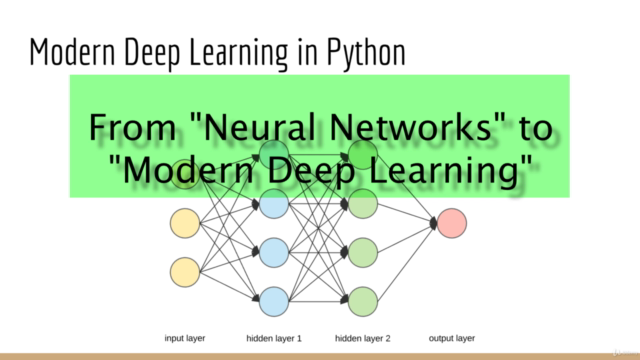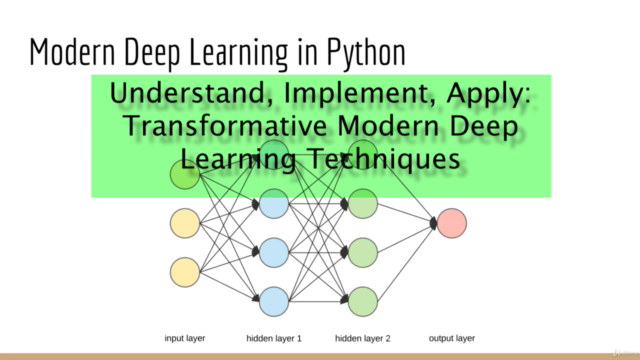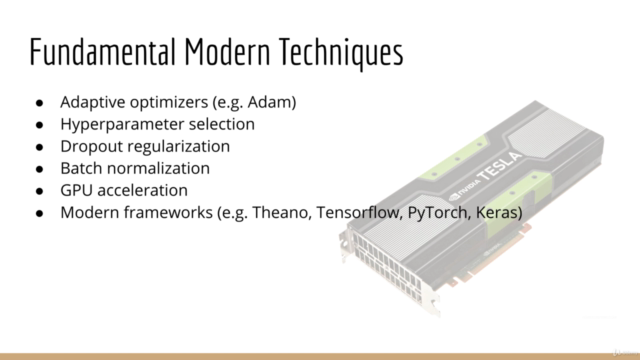Data Science: Modern Deep Learning in Python

Why take this course?
🌟 Master Data Science with Modern Deep Learning Techniques! 🌟
Course Title:
Data Science: Modern Deep Learning in Python
Course Headline:
Build with modern libraries like Tensorflow, Theano, Keras, PyTorch, CNTK, MXNet. Train faster with GPU on AWS.
Course Description:
Are you fascinated by the capabilities of cutting-edge AI technologies like OpenAI's ChatGPT, GPT-4, DALL-E, Midjourney, and Stable Diffusion? These aren't just buzzwords; they represent the pinnacle of machine learning innovation. In this course, you'll dive deep into the foundations and mechanisms behind these groundbreaking applications!
This course is an advanced follow-up to my initial Deep Learning in Python course where you learned the basics of building artificial neural networks in Python with TensorFlow. If you have a solid grasp on neural networks and are eager to enhance your deep learning expertise, this is your next step! 🚀
Unlock the Secrets of Modern Neural Networks:
- Master batch and stochastic gradient descent, which can significantly accelerate your training process.
- Explore techniques like momentum to navigate through local minima more effectively.
- Discover adaptive learning rate methods such as AdaGrad, RMSprop, and Adam.
We'll delve into advanced topics including:
- Dropout regularization to combat overfitting.
- Batch normalization techniques that are crucial for training deep neural networks efficiently.
Why Choose This Course?
- Comprehensive Coverage: From TensorFlow's basics to advanced techniques, we cover it all.
- Versatile Libraries: We'll explore Theano, Keras, PyTorch, CNTK, and MXNet. Use the one that fits your style best!
- GPU Training: Learn to leverage AWS GPU instances to supercharge your training processes.
- Real-World Datasets: Get hands-on with the classic MNIST dataset to test and refine your models.
Course Highlights:
- Hands-On Learning: Implement machine learning algorithms from the ground up for true understanding.
- Experimentation Focus: Visualize model internals and learn by doing, not just following code snippets.
- Expert Guidance: Unlike other courses that merely show you how to use libraries, here you'll learn to create machine learning models from scratch.
Prerequisites:
You should have a grasp of:
- Gradient Descent concepts and methods.
- Basic knowledge of Probability and Statistics.
- Proficiency in Python coding with constructs like if/else, loops, lists, dicts, sets.
- Familiarity with Numpy for matrix and vector operations as well as loading CSV files.
- Knowledge on how to write a neural network using Numpy.
Order of Learning:
To get the most out of my courses, I recommend following the roadmap provided in the FAQ section of any of my courses, including the free Numpy course. This will guide you through the optimal learning pathway.
Embark on a deep dive into the world of Data Science and Artificial Intelligence with this comprehensive course. Elevate your skills by mastering modern deep learning techniques and gain the ability to innovate like a pro! 🤖💡
Course Gallery




Loading charts...
Comidoc Review
Our Verdict
The Data Science: Modern Deep Learning in Python course offers a comprehensive overview of modern deep learning techniques and libraries, with an emphasis on hands-on practice through in-depth explanations and practical examples. While setup processes can initially pose challenges, learners will find the course rewarding as they develop their understanding of key concepts and delve into contemporary AI applications.
What We Liked
- Holistic approach to deep learning, covering modern libraries like TensorFlow, Theano, Keras, PyTorch, CNTK, and MXNet
- In-depth explanations of key concepts such as momentum, adaptive learning rate procedures, dropout regularization, and batch normalization
- Practical examples and assignments that encourage learners to derive formulas and write their own code
- Covers foundational knowledge for popular AI models like OpenAI ChatGPT, GPT-4, DALL-E, Midjourney, and Stable Diffusion
Potential Drawbacks
- Some users may find the initial setup process slightly frustrating due to reliance on Linux and limited guidance in code setup
- Explanations for some algorithms could be more detailed, with clearer connections between formulas and their implementations
- Outdated programming examples using Theano and TensorFlow 1.x; users would benefit from updated content using the latest libraries and APIs